

/en/access2010/working-with-tables/content/
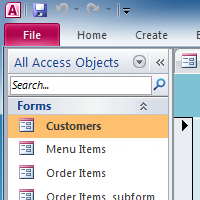
While you can always enter data directly into database tables, you might find it easier to use forms. Using a form to enter data lets you make sure you're entering the right data in the right location and format. This can help keep your database accurate and consistent.
This lesson will address the benefits of using forms in a database. You will review examples of different forms and form components. Finally, you will learn how to use forms to enter new records and view and edit existing ones.
Many of us fill out forms so often that we hardly even notice when we're asked to use them. Forms are so popular because they're useful for both the person asking for the information and the person providing it. They are a way of requiring information in a specific format, which means the person filling out the form knows exactly which information to include and where to put it.
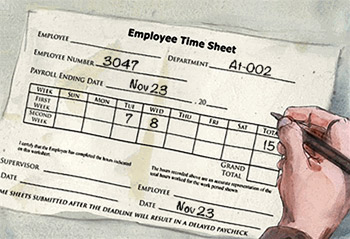 Filling out a paper form
Filling out a paper formThis is just as true of forms in Access. When you enter information into a form in Access, the data goes exactly where it's supposed to go: into one or more related tables. While entering data into simple tables is fairly straightforward, data entry becomes more complicated as you start populating tables with records from elsewhere in the database. For instance, the Orders table in a bakery's database might link to information about customers, products, and prices drawn from related tables. A record with information about a single order might look like this:
 A record of an order
A record of an orderIn fact, in order to see the entire order you would also have to look at the Order Items table, where the menu items that make up each order are recorded.
 More records describing the same order
More records describing the same orderThe records in these tables include ID numbers of records from other tables. You can't learn much just by glancing at these records because the ID numbers don't tell you much about the data they relate to. Plus, because you have to look at two tables just to view one order, you might have a challenging time even finding the right data. It's easy to see how viewing or entering many records this way could become a difficult and tedious task.
A form containing the same data might look like this:
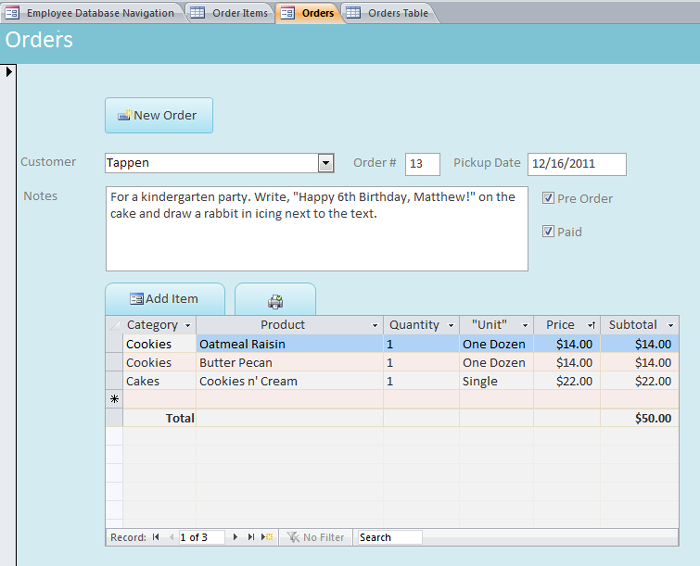 The same order viewed in a form
The same order viewed in a formAs you can see, this record is much easier to understand when viewed in a form. Modifying the record would be easier as well because you wouldn't have to know any ID numbers to enter new data. When you're using a form, you don't have to worry about entering data into the right tables or in the right format; the form can handle those things itself. There's no need to go back and forth between tables or to search carefully within a table for a certain record because forms let you see entire records one at a time.
Not only do forms make the data entry process easier for users, but they also keep the database itself working smoothly. With forms, database designers can control exactly how users are able to interact with the database. They can even set restrictions on individual form components to ensure all of the needed data is entered and that it's all entered in a valid format. This is useful because keeping data consistent and organized is essential for an accurate and powerful database.
To work with forms in Access, you'll need to know how to open a form, as well as how to view and edit the information in a form.
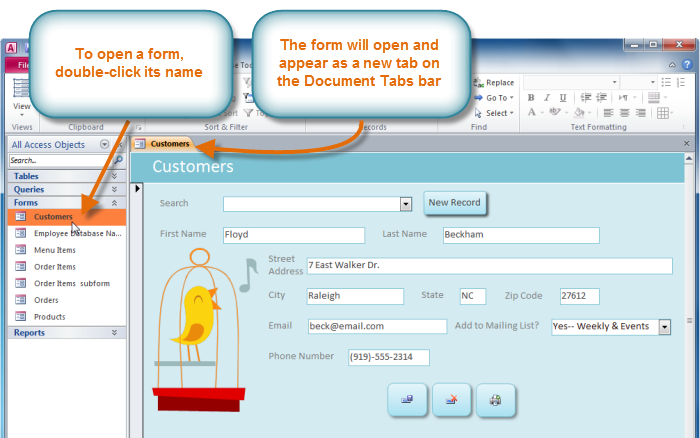 Opening a form
Opening a formDepending on the database you're using, the forms you work with may include special tools and features that let you complete common tasks with one click of a button. You'll see examples of these tools in the interactives later in this lesson. However, regardless of which type of form you're working with you can follow the same procedures for carrying out certain basic tasks.
There are two ways to add a new record to a form:
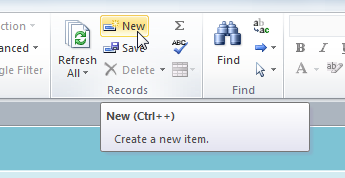 Creating a new record from the Ribbon
Creating a new record from the Ribbon Creating a new record from the Record Navigation bar
Creating a new record from the Record Navigation barThere are two ways to find and view an existing record using a form, and they both use the navigation bar at the bottom of the screen:
 Navigating through records
Navigating through records Searching for a record
Searching for a record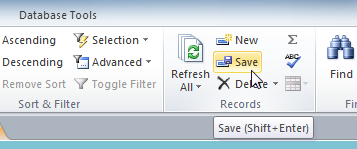 Saving a record
Saving a record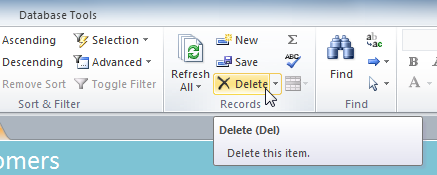 Deleting a record
Deleting a recordThe exact procedure you use for filling out a form will vary depending on the content and design of the form you are using. The forms in your database might be similar to the examples in the two interactives below. Between them, they include most of the features you'll commonly encounter in forms.
Click the buttons in the interactive below to learn about a simple form.

Form buttons can provide quick and easy ways to carry out common tasks. Buttons are usually labeled with text or with icons similar to those used on the Ribbon or Quick Access toolbar. From left to right, the buttons here allow a user to save, delete, and print the current record.

To guarantee users only enter valid responses, database designers may use a combo box, which lets users enter data by choosing from a drop-down list of choices.

If the database designer has created any rules specifying what type of data can be entered in each field, these rules will be reflected in the related forms. If you encounter a message like this one, simply click OK and re-enter the data following the instructions in the dialog box.
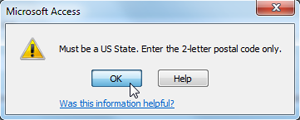
Clicking the New Record button will create a new record with all fields cleared except for fields with a default value.

This drop-down search box allows you to search for existing records. Simply begin typing, and records that match your search will appear in the drop-down list. You can also browse existing records by clicking the drop-down arrow and scrolling through the list of records.

Most data entry using forms is done with labeled text boxes. A text box is the Access equivalent of the blank space where you would write your information on a paper form. To enter data into a text box, simply click inside the text box and begin typing.
![]()
Click the buttons in the interactive below to learn about a complex form.

There are only two valid responses for the Pre Order and Paid fields in our related table: yes and no. Check boxes give users an easy way to input this data. Simply click the check box for yes or leave it unchecked for no.

Because the Pickup Date field on the related form only accepts information formatted as a date, the Pickup Date text box includes a calendar button to ensure users can only enter a date in the desired format. Requiring dates to be entered in a consistent format ensures that the database will recognize each entry in this field as a date.

In our database, order items are stored in a separate table from the orders themselves. To enter and display order data, this form includes an embedded subform and a table. This orders table can be viewed and searched like a normal table, but it only includes data linked to this particular order.

This button launches the subform that allows you to add a new record to the embedded table. When using a subform like this, enter the data as you would in a normal form, then click Save and Close. The new record will be displayed in the embedded table.
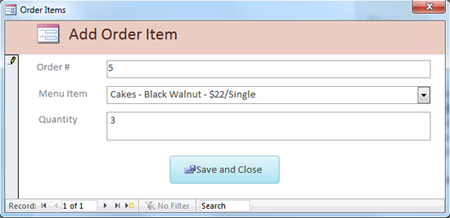
Instead of typing a customer name into a text box, anyone using this form must select a name from this drop-down list. This means users can only record orders from customers whose information has already been entered into the database. Requiring that each order is linked to an actual customer record helps preserve the integrity of a database.

This customized button will create a new record with all fields cleared. Note that the subform is also totally cleared.
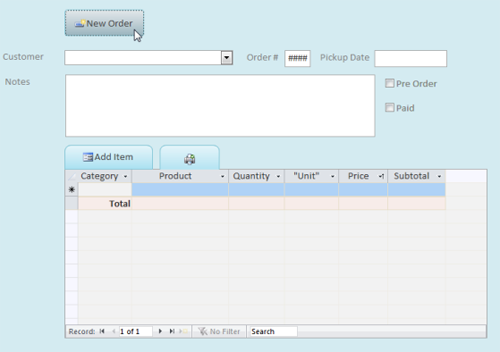
/en/access2010/sorting-and-filtering-records/content/